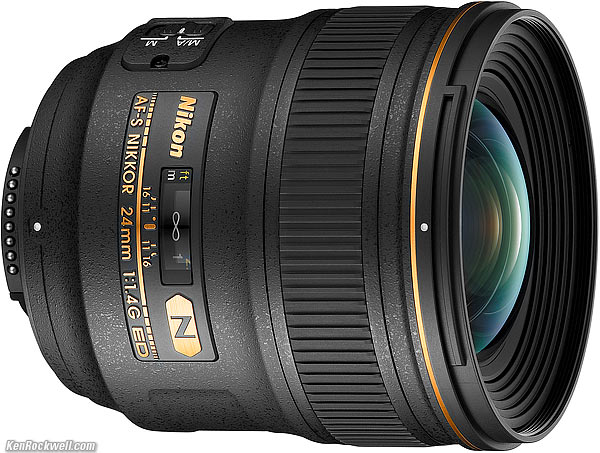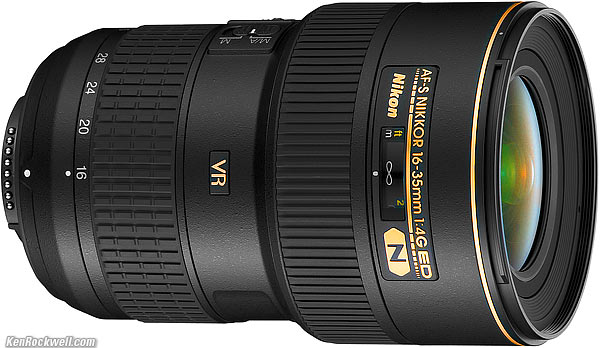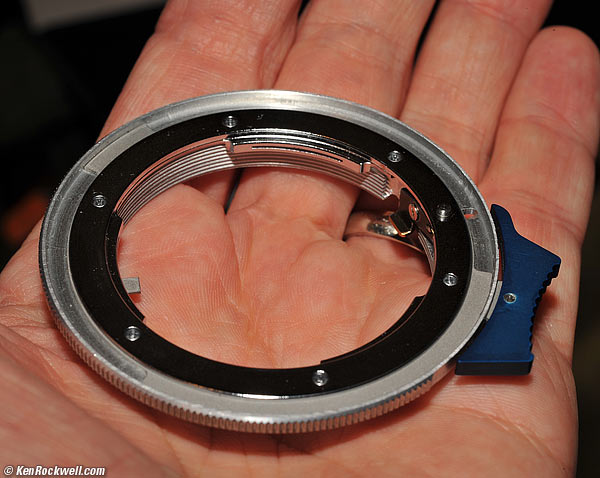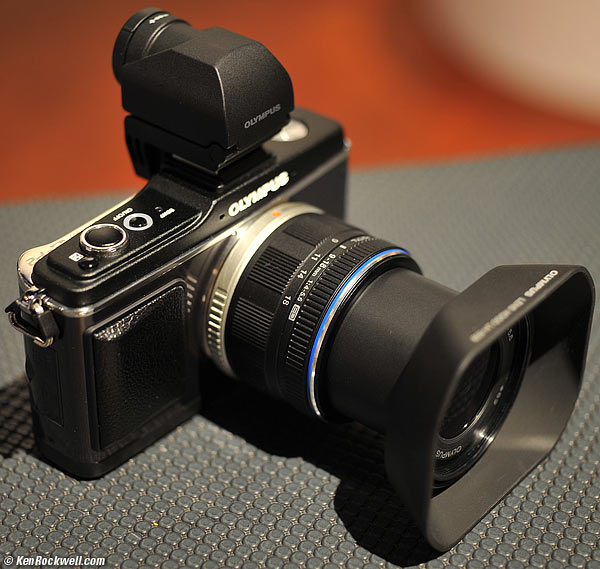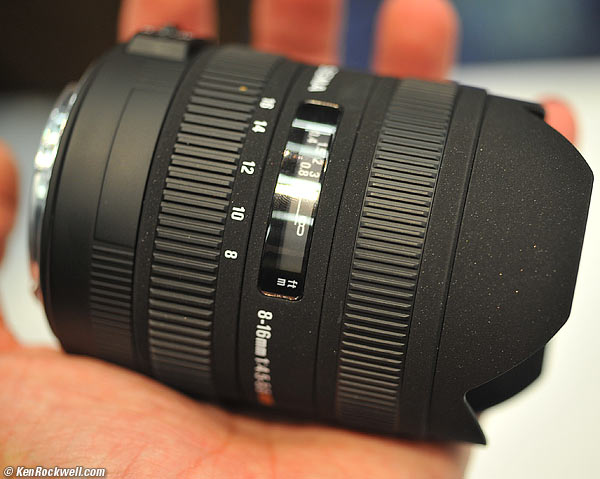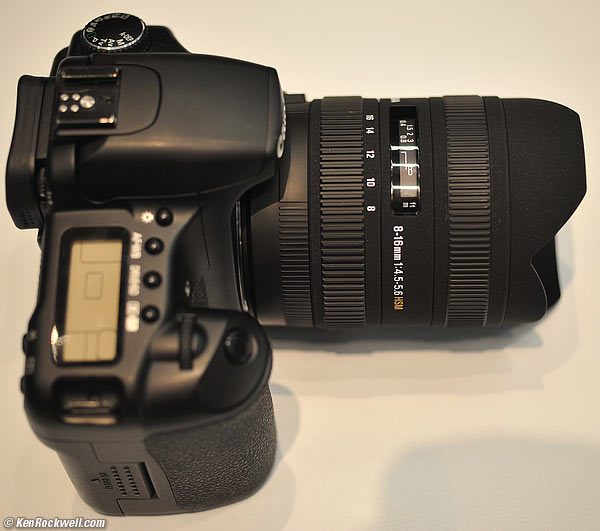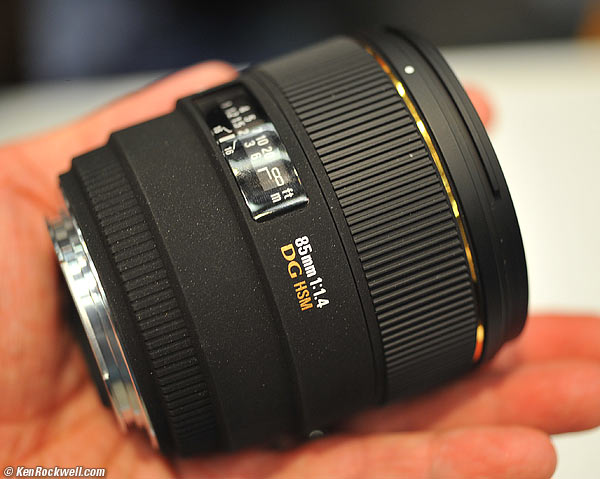Home Donate New Search Gallery How-To Books Links Workshops About Contact
PMA 2010 Report: Page 2
© 2010 KenRockwell.com. All rights reserved.
It helps me keep adding to this site when you use these links to Adorama, Amazon, B&H, Calumet, Ritz, J&R and eBay to get your goodies. Thanks! Ken.
February 2010
Nikon top
D700x
There is no D700x.
Nikon apparently decided to milk the 24MP market with the D3X for at least a few more months. If you need 24MP today, get the Canon 5D Mark II.
24mm f/1.4 top
Nikon 24mm f/1.4. Developing review.
I got to shoot a little with the Nikon 24mm f/1.4. It is extraordinary. See the performance section of my review for my latest comments.
16-35mm f/4 VR top
Nikon 16-35mm VR. Developing review.
I also got to play with the newest Nikon 16-35mm f/4 VR. It was a prototype, so I can't say anything about its optical performance. VR worked to about 1/4 second at 16mm.
It feels great. It feels much lighter than the 17-35mm f/2.8.
Novoflex top
Adapters
Novoflex Nikon G to Canon EOS Adapter. bigger.
Novoflex announced a slew of adapters, especially a Nikon G to Canon EOS adapter. You use this to use the spectacular Nikon 14-24mm on the Canon 5D Mark II, since Canon makes no wide zooms as good as that Nikon.
It's all mechanical; you stop-down the diaphragm with the blue lever.
Olympus top
Olympus E-P2, EVF, and prototype of new 9-18mm lens. bigger.
The E-P2 is the same as the E-P1, with an optional port into which you can plug a small viewfinder, or a stereo mic for video.
The little E-P2 finder is unlike any other electronic viewfinder (EVF) I have ever seen. Unlike everything else, the E-P2's accessory external viewfinder has enough resolution so you don't see every pixel as in every other sorry finder.
With the E-P2's external finder, you can actually see what you're seeing!
No, the E-P2's and the Panasonic GF1's finders do not interchange, even if the port looks similar and the lenses interchange.
Panasonic top
The GF1 is still Panasonic's hot ticket. I have to get one in my hot little hands, AF seems far faster than it has any right to be. This could be the future for serious digital photography.
Seagull top
2-¼" TLRs
Seagull of China showed some of their usual TLRs.
Sadly, no one spoke English and they have no official US importer.
Shen-Hao top
View Cameras
Shen-Hao of China showed a table full of nice 4x5," 5x7," 8 x 10," 6 x 17 cm, 6 x 24 cm, 4 x 10," 5 x 12" and 7 x 17" view cameras and backs.
Sadly, no one spoke English and they have no official US importer.
Sigma top
Sigma 8-16mm non-distorting DX ultrawide!
Sigma 8-16mm ultrawide. bigger.
Sigma just announced the world's widest non-distorting lens for DX and 1.6x Canon cameras, an 8-16mm f/4.5-5.6.
Whoo hoo! This is not a fisheye: straight lines stay straight!
It feels like most of Sigma's more expensive lenses: ugly paint, and smoother than average (for Sigma) zoom and focus controls.
It gives an equivalent angle-of-view to what a 12-24mm lens sees on film or full-frame.
It is a lot smaller than Sigma's 12-24mm full-frame lens, and as slow (dark) as the 12-24mm full-frame.
This lens is wider than anything from Nikon or Canon that doesn't distort for little digital SLRs. Whoo hoo!
Sigma calls this the 8-16mm F4.5-5.6 DC HSM. Sigma's PR says "The Sigma 8-16mm F4.5-5.6 DC HSM is the first ultra-wide zoom lens with a minimum focal length of 8mm, designed specifically for APS-C size image sensors. This lens has an equivalent angle of view of a 12-24mm lens when used on digital cameras with an APS-C size image sensor. The wide-angle of view from 121.2 degrees* produces striking images with exaggerated perspective, enabling photographers to emphasize the subject. Four FLD glass elements, which have the performance equal to fluorite glass, compensate for color aberration. One hybrid aspherical lens and two glass mold elements give excellent correction for distortion and astigmatism. Incorporating an inner focusing system, the lens produces high-definition images throughout the entire zoom range. The Super Multi-Layer Coating reduces flare and ghosting while superior peripheral brightness ensures high contrast images throughout the entire zoom range. This lens incorporates Hyper Sonic Motor (HSM), ensuring quiet and high speed auto focus, as well as full-time manual focus capability. It has a minimum focusing distance of 9.4 inches throughout the entire zoom range, which allows photographers to emphasize the subject by creating exaggerated perspectives. This lens has a compact construction with an overall length of 4.2 inches and a maximum diameter of 2.9 inches."
Sigma 8-16mm on a Canon. Bigger.
Specifications: Sigma 8-16mm
Coverage: DX, Canon 1.6x, Sigma 1.7x.
Diagonal angle-of-view: up to 121.2º.
Optics: 15 elements in 11 groups. Four are ED, one is a hybrid (half plastic) aspherical, and two are molded aspherical elements. Internal focus.
Diaphragm: 7-blades, stops down to f/22.
Close focus: 0.8 feet (0.24m).
Maximum Reproduction Ratio: 1:7.8.
Size: 3" (75mm) diameter by 4.2" (105.7mm) long.
Weight: 19.2 oz. (545g).
Filters: NONE.
Mounts: Nikon, Canon, Minolta AF (Sony), Pentax and Sigma.
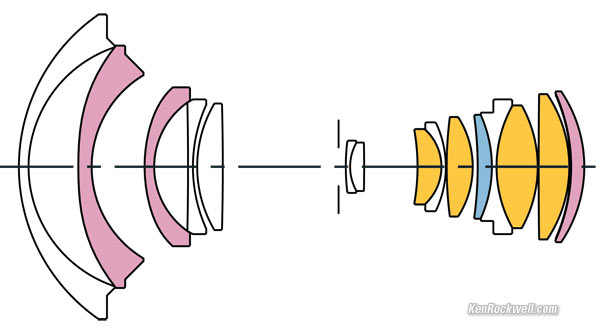
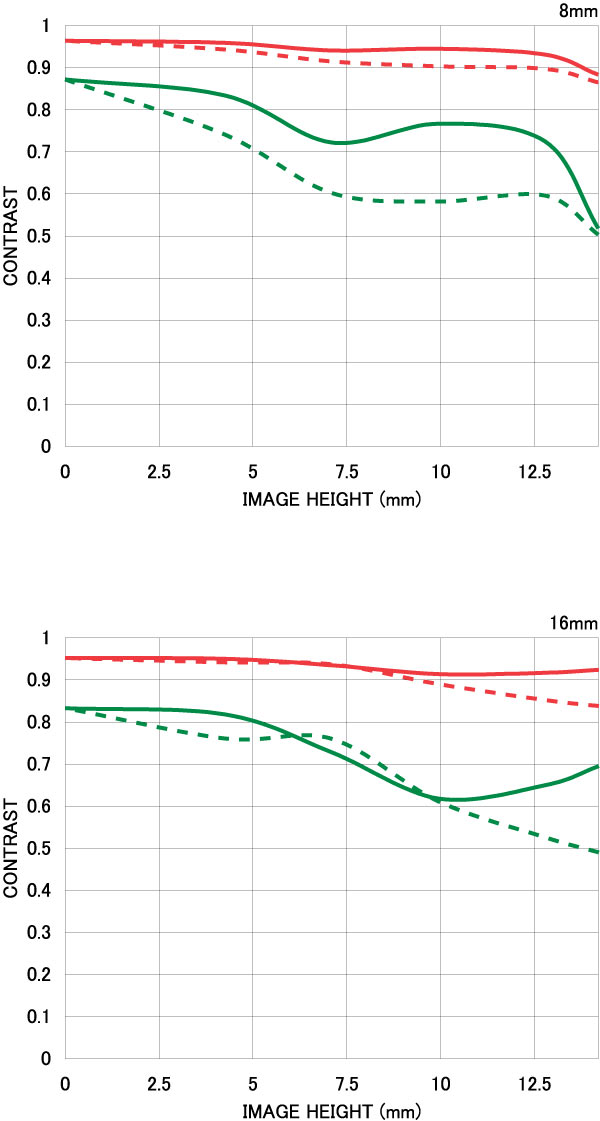
Sigma 85mm f/1.4 (FX) top
Nikon and Canon have been making these for years. Sigma now has one, too.
Sigma 85mm f/1.4. bigger.
Specifications: Sigma 85mm f/1.4
Coverage: Full-frame and smaller.
Optics: 11 elements in 8 groups. One is ED, and one is a molded aspherical. Rear focus.
Diaphragm: 9 rounded blades, stops down to f/16.
Close focus: 2.8 feet (0.85m).
Maximum Reproduction Ratio: 1:8.6.
Size: 3.3" (84.7mm) diameter by 3.4 " (87.6mm) long.
Weight: Not yet specified.
Hood: Comes with an adapter to let it work great with either full-frame or little-sensor cameras.
Filters: 77mm.
Mounts: Nikon G, Canon, Minolta AF (Sony), Pentax and Sigma.
Sigma calls this the 85mm F1.4 EX DG HSM and their PR says "The Sigma 85mm F1.4 EX DG HSM is a large aperture, medium telephoto lens optimized for use with digital SLR cameras features a focal length of 85mm, ensuring a natural perspective. The large aperture of F1.4 is especially ideal for portrait and low light photography. When used on digital cameras with an APS-C size image sensor, the lens effectively becomes a 127.5mm F1.4 lens. One Special Low Dispersion (SLD) glass element and one glass mold element give excellent correction for all types of aberrations and ensure superior optical performance. This lens is equipped with a rear focus system that minimizes fluctuation of aberration caused by focusing. The Super Multi-Layer Coating reduces flare and ghost, even in backlight photography. Incorporating Hyper Sonic Motor (HSM), this lens provides quiet and high-speed auto focus, as well as full-time manual focus capability. It features a minimum focusing distance of 33.5 inches and a maximum magnification 1:8.6. This lens has a round, nine-blade diaphragm, which creates an attractive blur to the out of focus images. This lens is supplied with a petal-type hood to block out extraneous light. For digital cameras with an APS-C size image sensor, a dedicated hood adapter, which expands the length of the lens hood, is supplied and enables the hood to block out extraneous light more effectively."
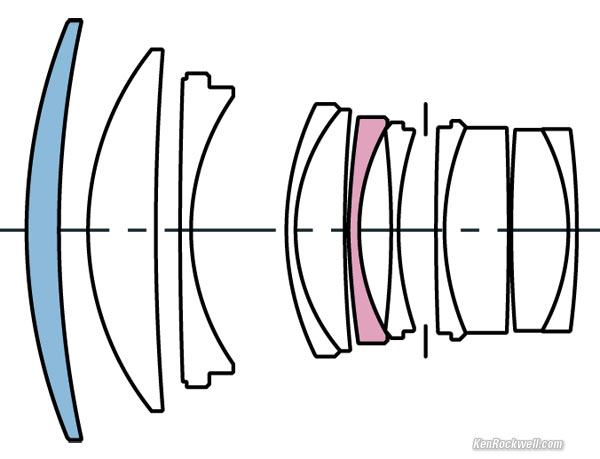
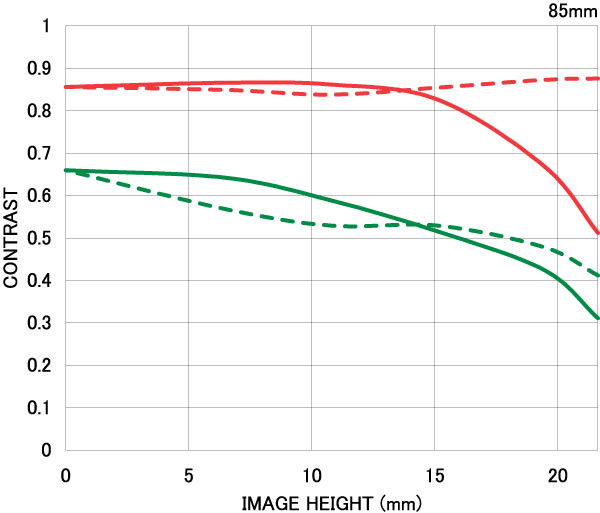
Sigma 17-50/2.8 DX top
No big deal, since we can get lenses like this from Nikon and Canon.
Sigma calls this an APO 17-50mm F2.8 EX DC OS HSM, and their PR says "The Sigma 17-50mm F2.8 EX DC OS HSM is a large aperture standard zoom lens designed for digital SLR cameras. It incorporates Sigma’s efficient Optical Stabilization (OS) function and is a compact lens with an overall length of just 3.6 inches. This lens covers a focal length from 17mm wide angle and offers a large aperture of F2.8 throughout the entire zoom range, making it ideal for many types of photography such as portraiture and landscapes. The OS function offers the use of shutter speeds approximately four stops slower than would otherwise be possible. For Sony and Pentax mount, the built-in OS function of this lens can be used even if the camera body is equipped with an image sensor shift anti-shake system. As compensation for camera shake is visible in the viewfinder, the photographer can easily check for accurate focus and ensure there is no subject movement. Two FLD glass elements, which have performance equal to fluorite glass, plus two glass mold and one hybrid aspherical lens, provide excellent correction for all types of aberrations. The Super Multi-Layer Coating reduces flare and ghost. This lens has superior peripheral brightness and provides sharp, high-contrast images even at the maximum apertures. High image quality is assured throughout the entire zoom range. Incorporating Hyper Sonic Motor (HSM), the lens provides fast and quiet auto focus. The lens has a minimum focusing distance of 11 inches throughout the entire zoom range and a maximum magnification ratio of 1:5. The rounded seven-blade diaphragm creates an attractive blur to the out of focus images. The inner focusing system eliminates front lens rotation, making the lens particularly suitable for use with the supplied petal-type lens hood and circular polarizing filters."
Sigma 50-500mm VR top
This is a slow lens with which the AF systems of Nikon and Canon are not likely to be happy. Personally, I'd use the Canon 100-400mm L IS or the Nikon 80-400mm VR or 70-300mm VR instead.
Sigma calls this an APO 50-500mm F4.5-6.3 DG OS HSM and their PR says "The Sigma APO 50-500mm F4.5-6.3 DG OS HSM is a 10x high-zoom ratio, ultra telephoto zoom lens incorporating Sigma’s original Optical Stabilization (OS) function. This lens covers a wide range of focal lengths from 50mm to 500mm ultra telephoto. The OS function offers the use of shutter speeds approximately four stops slower than would otherwise be possible. For Sony and Pentax mount, the built-in OS function of this lens can be used even if the camera body is equipped with an image sensor shift anti-shake system. As compensation for camera shake is visible in the view finder, the photographer can easily check for accurate focus and ensure there is no subject movement. Four Special Low Dispersion (SLD) glass elements provide excellent correction of color aberration. The Super Multi-Layer Coating reduces flare and ghosting, and ensures high image quality throughout the entire zoom range. This lens has a maximum magnification ratio of 1:3.1 (at the focal length of 200mm), making it ideal for close-up photography. This lens incorporates Hyper Sonic Motor (HSM), ensuring quiet and high-speed auto focus, as well as full-time manual focus capability. The addition of the optional 1.4x EX DG or 2x EX DG APO Tele Converters produce a 70-700mm F6.3-8 or a 100-1000mm F9-12.6 MF zoom lens, respectively. This lens is equipped with a petal-type hood to block out extraneous light. The filter size of this lens is φ95mm and the lens is supplied with a step-down ring enabling digital cameras with an APS-C size image sensor to use a φ86mm filter."
Sigma 70-200/2.8 VR top
I know of no reason to buy this lens. The only reason newcomers to the hobby buy these is because the new price seems less, but when you go to sell it to upgrade later to the Nikon or Canon lens you really wanted, you just paid twice. Worse, used Sigma lenses aren't worth very much in trade.
I'd buy the extraordinary Nikon 70-200 VR II or Canon 70-200 L IS instead. Not only are they better lenses, they cost less when you look at what you pay now, how long you'll get to use them, and how much you'll get for them if you want to sell them later.
If price matters, get the Nikon 80-200/2.8 AF-D, or the Canon 70-200mm f/4 L IS, which is the sharpest zoom I've ever used. I'd also prefer either of these fully professional lenses to the Sigma, and I bet either of these cost less than the Sigma.
If you're really cheap (I know I am), buy any of these four Nikon or Canon pro zooms just mentioned used. They will cost less than new Sigma, and if you go to sell them, you'll probably get more than you paid in a few years.
Sigma calls this the APO 70-200mm F2.8 EX DG OS HSM, and their PR says "The Sigma APO 70-200 F2.8 EX DG OS HSM is a large aperture, telephoto zoom lens that incorporates Sigma’s original Optical Stabilization (OS) function. The lens covers a medium telephoto range of focal lengths from 70mm to 200mm and has a large maximum aperture of F2.8 throughout the entire zoom range. The OS function offers the use of shutter speeds approximately four stops slower than would otherwise be possible. For Sony and Pentax mounts, the built-in OS function of this lens can be used even if the camera body is equipped with an image sensor shift anti-shake system. As compensation for camera shake is visible in the view finder, the photographer can easily check for accurate focus and ensure there is no subject movement. Two FLD (“F” Low Dispersion) glass elements, which have the performance equal to fluorite glass, and three SLD (Special Low Dispersion) glass elements provide excellent correction of color aberration. High image quality is assured throughout the entire zoom range and an optimum optical power layout provides superior optical quality in all shooting ranges from close-up to infinity. Super Multi-Layer Coating reduces flare and ghosting. This lens incorporates Hyper Sonic Motor (HSM), ensuring a quiet and high-speed auto focus, as well as full-time manual focus capability. The lens has a minimum focusing distance of 55.1 inches throughout the entire zoom range and a maximum magnification ratio of 1:8. The rounded, nine-blade diaphragm creates an attractive blur to the out of focus images. This lens is equipped with a petal-type hood. For digital cameras with an APS-C size image sensor, a dedicated hood adapter, which expands the length of the lens hood, is supplied."
Sigma SD15 DSLR (1.7x crop factor, 4.7MP) top
Sigma's PR says (they lie about resolution, which is why they say 14MP): "The SD15 Digital SLR camera is the latest model in Sigma’s SD series. Powered by the 14-megapixel Foveon X3 direct image sensor, it can capture all primary RGB colors at each and every pixel location arranged in three layers. The new SD15 incorporates the “TRUE II” image processing engine, which processes the large amount of data from the 14 megapixel direct image sensor. It also provides high resolution power and reproduces high definition images with impressive three-dimensional detail, rich in gradation. The camera adopts the SD card and incorporates a highly visible 3.0 inch LCD monitor, 77-Segment AE sensor and Analog Front End (AFE). It provides high image quality and user friendly design. In addition, the durable shutter mechanism, which has a life of over 100,000 actuations, is ideal for the demands of digital photography."
Page 1 Page 2 Next: Page 3
Help me help you top
I support my growing family through this website, as crazy as it might seem.
If you find this as helpful as a book you might have had to buy or a workshop you may have had to take, feel free to help me continue helping everyone.
If you've gotten your gear through one of my links or helped otherwise, you're family. It's great people like you who allow me to keep adding to this site full-time. Thanks!
If you haven't helped yet, please do, and consider helping me with a gift of $5.00.
The biggest help is to use these links to Adorama, Amazon, Calumet, Ritz and J&R when you get your goodies. It costs you nothing and is a huge help. These places have the best prices and service, which is why I've used them since before this website existed. I recommend them all personally.
Thanks for reading!
Ken
Home Donate New Search Gallery How-To Books Links Workshops About Contact

